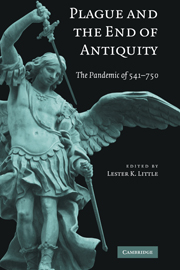Book contents
- Frontmatter
- Contents
- Contributors
- Preface
- Map
- Plague and the End of Antiquity
- I INTRODUCTION
- II THE NEAR EAST
- III THE BYZANTINE EMPIRE
- IV THE LATIN WEST
- V THE CHALLENGE OF EPIDEMIOLOGY AND MOLECULAR BIOLOGY
- 11 Ecology, Evolution, and Epidemiology of Plague
- 12 Toward a Molecular History of the Justinianic Pandemic
- Bibliography
- Index
12 - Toward a Molecular History of the Justinianic Pandemic
Published online by Cambridge University Press: 05 June 2012
- Frontmatter
- Contents
- Contributors
- Preface
- Map
- Plague and the End of Antiquity
- I INTRODUCTION
- II THE NEAR EAST
- III THE BYZANTINE EMPIRE
- IV THE LATIN WEST
- V THE CHALLENGE OF EPIDEMIOLOGY AND MOLECULAR BIOLOGY
- 11 Ecology, Evolution, and Epidemiology of Plague
- 12 Toward a Molecular History of the Justinianic Pandemic
- Bibliography
- Index
Summary
Disease has a deep history. Modern “plagues” have made historians sensitive to the problem of human illness and suffering in the past, and even the broader public is drawn to questions of catastrophic change, disease, and the decline of the ancient world. Historians have long used the medical science of their day to illuminate historical records of plague. Medical research of the first half of the twentieth century underpinned Biraben's pioneering work on both the Justinianic and the medieval plagues. In no small part, Benedictow challenged some of that analysis because of medical progress forced by the outbreaks of bubonic plague (Yersinia pestis) during the American war in Vietnam. A decade later, the advances of molecular biology are assuming revolutionary proportions and oblige us to consider the issues anew.
Every passing week deepens biologists' understanding of DNA, how it works, and its implications for all life forms. The development of the PCR (polymerase chain reaction) procedure allows swift and accurate amplification and sequencing of DNA from very small quantities. This makes possible the identification of the genomes of various organisms, and that illuminates the molecular processes of disease and life itself. New outbreaks of plague add to the clinical and epidemiological data. Even leaving aside the problem of bioterrorism, the World Health Organization has classified bubonic plague as a newly reemergent disease.
- Type
- Chapter
- Information
- Plague and the End of AntiquityThe Pandemic of 541–750, pp. 290 - 312Publisher: Cambridge University PressPrint publication year: 2006
- 4
- Cited by

